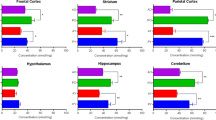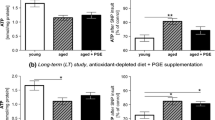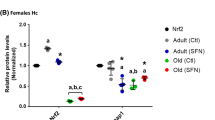Abstract
The accumulation of oxidative damage is believed to contribute to senescence. We have previously found that the consumption of green tea catechins (GT-catechin), which are potent antioxidants, decreases oxidative damage to DNA and improves brain function in aged mice with accelerated senescence (SAMP10 mice). To investigate the mechanisms underlying the beneficial effects of GT-catechin, we measured the activities of antioxidative enzymes in the brains of aged SAMP10 mice. The activity of glutathione peroxidase (GPx), an essential enzyme for reduction of hydrogen and lipid peroxides, was significantly lower in aged mice than in younger ones. However, the decline in activity was prevented in aged mice that had consumed GT-catechin. The increased level of carbonyl proteins, a marker of oxidative damage in proteins, was also significantly reduced in aged mice that had consumed GT-catechin. The activities of superoxide dismutase and catalase were not decreased in aged mice. These results suggest that decreased activity of GPx importantly contributes to brain dysfunction in ageing SAMP10 mice. Furthermore, the intake of GT-catechin protected the decline in GPx activity and age-related oxidative damage in the brain.



Similar content being viewed by others
Abbreviations
- ECG:
-
(−)-Epicatechin gallate
- EGC:
-
(−)-Epigallocatechin
- EGCG:
-
(−)-Epigallocatechin gallate
- GPx:
-
Glutathione peroxidase
- GR:
-
Glutathione reductase
- GSH:
-
Reduced glutathione
- GSSG:
-
Glutathione disulfide
- GT-catechin:
-
Green tea catechins
- NO:
-
Nitric oxide
- ROS:
-
Reactive oxygen species
- SAMP10:
-
A mouse strain with accelerated senescence
- SAMR1:
-
Senescence-resistant inbred strain
- SNAP:
-
S-nitro-N-acetyl-DL- penicillamine
- SOD:
-
Superoxide dismutase
- TCA:
-
Trichloroacetic acid
References
Aebi H (1984) Catalase in vitro. Meth Enzymol 105:121–126
Asahi M, Fujii J, Suzuki K, Seo HG, Kuzuya T, Hori M, Tada M, Fujii S, Taniguchi N (1995) Inactivation of glutathione peroxidase by nitric oxide. J Biol Chem 270:21035–21039
Asahi M, Fujii J, Takao T, Kuzuya T, Hori M, Shimonishi Y, Taniguchi N (1997) The oxidation of selenocysteine is involved in the inactivation of glutathione peroxidase by nitric oxide donor. J Biol Chem 272:19152–19157
Baud O, Greene AE, Li J, Wang H, Volpe JJ, Rosenberg PA (2004) Glutathione peroxidase-catalase cooperativity is required for resistance to hydrogen peroxide by mature rat oligodendrocytes. J Neurosci 24:1531–1540
Crack PJ, Taylor JM, Flentjar NJ, de Haan J, Hertzog P, Lannello RC, Kola I (2001) Increased infarct size and exacerbated apoptosis in the glutathione peroxidase-1 (Gpx-1) knockout mouse brain in response to ischemia/reperfusion injury. J Neurochem 78:1389–1399
de Haan JB, Bladier C, Griffiths P, Kelner M, O’Shea RD, Cheung NS, Bronson RT, Silvestro MJ, Wild S, Zheng SS, Beart PM, Hertzog PJ, Kola I (1998) Mice with a homozygous null mutation for the most abundant glutathione peroxidase, Gpx1, show increased susceptibility to the oxidative stress-inducing agents paraquat and hydrogen peroxide. J Biol Chem 273:22528–22536
Devi SA, Kiran TR (2004) Regional responses in antioxidant system to exercise training and dietary Vitamin E in aging rat brain. Neurobiol Aging 25:501–508
Dringen R, Pawlowski PG, Hirrlinger J (2005) Peroxide detoxification by brain cells. J Neurosci Res 79:157–165
Foster TC (2006) Biological markers of age-related memory deficits: treatment of senescent physiology. CNS Drugs 20:153–166
Ho Y-S, Magnenat J-L, Bronson RT, Cao J, Gargano M, Sugawara M, Funk CD (1997) Mice deficient in cellular glutathione peroxidase develop normally and show no increased sensitivity to hyperoxia. J Biol Chem 272:16644–16651
Kashima M. (1999) Effects of catechins on superoxide and hydroxyl radical. Chem Pharm Bull 47:279–283
Kidd PM (2005) Neurodegeneration from mitochondrial insufficiency: nutrients, stem cells, growth factors, and prospects for brain rebuilding using integrative managements. Altern Med Rev 10:268–293
Kimura M, Umegaki K, Kasuya Y, Sugusawa A, Higuchi M. (2002) The relation between single/double or repeated tea catechin ingestions and plasma antioxidant activity in humans. Eur J Clin Nutr 56:1186–1193
Levites Y, Weinreb O, Maor G, Youdim MBH, Mandel S. (2001) Green tea polyphenol (−)-epigallocatechin-3-gallate prevents N-methyl-4-phenyl-1,2,3,6-tetrahydropyridine-induced dopaminergic neurodegeneration. J Neurochem 78:1073–1082
Liddell JR, Hoepken HH, Crack PJ, Robinson SR, Dringen R (2006) Glutathione peroxidase 1 and glutathione are required to protect mouse astrosytes from Iron-mediated hydrogen peroxide toxicity. J Neurosci Res 84:578–586
Lindenau J, Noack H, Asayama K, Wolf G (1998) Enhanced cellular glutathione peroxidase immuno reactivity in activated astrosytes and in microglia during excitotoxine induced neurogeneration. Glia 24:252–256
Maier CM, Chen PH (2002) Role of superoxide dismutases in oxidative damage and neurodegenerative disorders. Neuroscientist 8:323–334
Nagai K, Jiang MHJ, Hada J, Nagata T, Yajima Y, Yamamoto S, Nishizaki T (2002) (−)-Epigallocatechin gallate protects against NO stress-induced neuronal damage after ischemia by acting as an anti-oxidant. Brain Res 965:319–322
Nakamura A, Goto S (1996) Analysis of protein carbonyls with 2,4-dinitrophenyl hydrazine and its antibodies by immunoblot in two dimensional gel electrophoresis. J Biochem 119:768–774
Nanjo F, Mori M, Goto K, Hara Y. (1999) Radical scavenging activity of tea catechins and their related compounds. Biosci Biotechnol Biochem 63:1621–1623
Numata T, Saito T, Maekawa K, Takahashi Y, Saitoh H, Hosokawa T, Fujita H, Kurasaki M (2002) Bcl-2-linked apoptosis due to increase in NO synthetase in brain of SAMP10. Biochem Biophys Res Commn 297:517–522
Reznick AZ, Packer RL (1994) Oxidative damage to proteins: spectrophotometric methods for carbonyl assay. Meth Enzymol 233:357–363
Sanz A, Caro P, Ibañez J, Gómez J, Gredilla R, Barja G (2005) Dietary restriction at old age lowers mitochondrial oxygen radical production and leak at complex I and oxidative DNA damage in rat brain. J Bioenerg Biomembr 37:83–90
Schulz JB, Lindenau J, Seyfried J, Dichgans J (2000) Glutathione, oxidative stress and neurodegeneration. Eur J Biochem. 267:4904–4911
Serrano F, Klann E (2004) Reactive oxygen species and synaptic plasticity in the aging hippocampus. Ageing Res Rev 3:431–443
Shimada A (1999) Age-dependent cerebral atrophy and cognitive dysfunction in SAMP10 mice. Neurobiol Aging 20:125–136
Shimada A, Keino H, Satoh M, Kishikawa M, Hosokawa M (2003) Age-related loss of synapses in the frontal cortex of SAMP10 mouse: a model of cerebral degeneration. Synapse 48:198–204
Shimada A, Keino H, Satoh M, Kishikawa M, Seriu N, Hosokawa M (2002) Age-related progressive neuronal DNA damage associated with cerebral degeneration in a mouse model of accelerated senescence. J Gerontol: Biol Sci Med Sci 57:B415–B421
Skrzydlewska E, Ostrowska J, Farbiszewski R, Michalak K. (2002) Protective effect of green tea against lipid peroxidation in the rat liver, blood serum and the brain. Phytomedicine 9:232–238
Skrzydlewska E, Augustyniak A, Michalak K, Farbiszewski R (2005) Green tea supplementation in rats of different ages mitigates ethanol-induced changes in brain antioxidant abilities. Alcohol 37:89–98
Suzuki M, Mabuchi M, Ikeda M, Umegaki K, Tomita T (2004) Protective effect of green tea catechins on cerebral ischemic damage. Med Sci Monit 10:BR166–BR174
Taylor JM, Ali U, Iannelo RC, Hertzog P, Crack PJ (2005) Diminished Akt phosphorylation in neurons lacking glutathione peroxidase-1 (GPx1) leads to increase susceptibility to oxidative stress-induced cell death. J Neurochem 92:283–293
Terao J (1999) Dietary flavonoids as antioxidants in vivo: conjugated metabolites of (−)-epicatechin and quercetin participate in antioxidative defense in blood plasma. J Med Invest 46:159–168
Unno K, Takabayashi F, Kishido T, Oku N. (2004) Suppressive effect of green tea catechins on morphologic and functional regression of the brain in aged mice with accelerated senescence (SAMP10). Exp Gerontol 39:1027–1034
Unno K, Takabayashi F, Yoshida H, Choba D, Fukutomi R, Kikunaga N, Kishido T, Oku N, Hoshino M (2006) Daily consumption of green tea catechin delays memory regression in aged mice. Biogerontology, Epub. Sept. 7
Wei I-H, Wu Y-C, Wen C-Y, Shieh J-Y (2004) Green tea polyphenol (−)-epigallocatechin gallate attenuates the neuronal NADPH-d/n NOS expression in the nodose ganglion of acute hypoxic rats. Brain Res 999:73–80
Zhu Y, Cavey PM, Ling Z (2006) Age-related changes in glutathione and glutathione-related enzymes in rat brain. Brain Res 1090:35–44
Author information
Authors and Affiliations
Corresponding author
Rights and permissions
About this article
Cite this article
Kishido, T., Unno, K., Yoshida, H. et al. Decline in glutathione peroxidase activity is a reason for brain senescence: consumption of green tea catechin prevents the decline in its activity and protein oxidative damage in ageing mouse brain. Biogerontology 8, 423–430 (2007). https://doi.org/10.1007/s10522-007-9085-7
Received:
Accepted:
Published:
Issue Date:
DOI: https://doi.org/10.1007/s10522-007-9085-7




